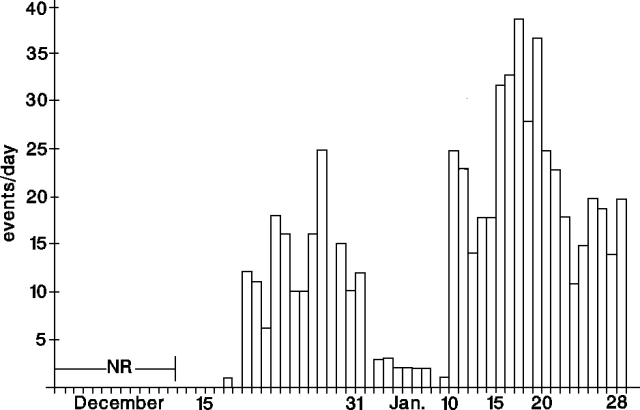Report on Arenal (Costa Rica) — January 1991
Bulletin of the Global Volcanism Network, vol. 16, no. 1 (January 1991)
Managing Editor: Lindsay McClelland.
Arenal (Costa Rica) Strombolian explosions resume as seismicity increases; lava flows
Please cite this report as:
Global Volcanism Program, 1991. Report on Arenal (Costa Rica) (McClelland, L., ed.). Bulletin of the Global Volcanism Network, 16:1. Smithsonian Institution. https://doi.org/10.5479/si.GVP.BGVN199101-345033
Arenal
Costa Rica
10.463°N, 84.703°W; summit elev. 1670 m
All times are local (unless otherwise noted)
Lava and gas emission continued during December, although there was an absence of explosions and only sporadic chugging noises (rhythmic block and bomb fountains) were heard. One group of small explosions was recorded by seismograph on 16 December. Strombolian explosions reappeared 10 January, throwing blocks and bombs ~1 km from Crater C. On 15-17 January, explosions were observed at a rate of 2-3/hour, with several stronger explosions producing ash columns to 1,000 m height. During January, the plume averaged 700 m high and was carried predominantly to the SW, W, and NW, over the region most affected by acid rain. A pH of 4.62 was measured in this area. Ash fell 7 km from the summit (on Lago Arenal and the Sangregado dam). Lava traveled down the N, NW, SW, and S flanks of the volcano, with the N and NW flows reaching ~900 m length by the end of January. Seismicity increased in January (figure 35). Nearly continuous tremor was recorded 2-3, 8-9, 10-17, 20-24, and 26 January.
Geological Summary. Conical Volcán Arenal is the youngest stratovolcano in Costa Rica and one of its most active. The 1670-m-high andesitic volcano towers above the eastern shores of Lake Arenal, which has been enlarged by a hydroelectric project. Arenal lies along a volcanic chain that has migrated to the NW from the late-Pleistocene Los Perdidos lava domes through the Pleistocene-to-Holocene Chato volcano, which contains a 500-m-wide, lake-filled summit crater. The earliest known eruptions of Arenal took place about 7000 years ago, and it was active concurrently with Cerro Chato until the activity of Chato ended about 3500 years ago. Growth of Arenal has been characterized by periodic major explosive eruptions at several-hundred-year intervals and periods of lava effusion that armor the cone. An eruptive period that began with a major explosive eruption in 1968 ended in December 2010; continuous explosive activity accompanied by slow lava effusion and the occasional emission of pyroclastic flows characterized the eruption from vents at the summit and on the upper western flank.
Information Contacts: G. Soto and R. Barquero, ICE; M. Fernández and W. Rojas, Univ de Costa Rica; J. Barquero and E. Fernández, OVSICORI.


